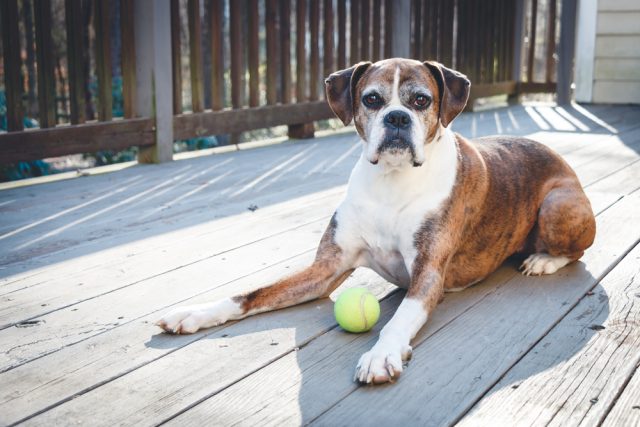You can’t teach an old dog new tricks is a saying that has been around for decades. But the fact is, you can teach an old dog new tricks, and it’s not that much different from teaching a younger dog. In fact, older dogs have some advantages – attention span being one – that might make them easier to train in some ways. However, there are a few things to think about when you are working with an older dog. The following is a list of the top 10 senior dog training tips. What have you taught your senior dog lately? Share in the comments!
#1 – Avoid Repetition
Old joints do not like doing the same thing over and over again. So avoid, for example, asking your dog to sit ten times in a row without a break. Doing so might cause pain and then your dog won’t want to respond.
RELATED: 7 Best Online Dog Training Courses
#2 – Keep Sessions Short
While this applies to all dogs, it’s really helpful for a senior dog. Not just because of boredom or information overload but because of fatigue and joint strain.
#3 – Talk to Your Vet Prior to Starting Something Strenuous
If you are thinking of doing something with your senior dog that may be strenuous, such as agility or dock diving, take them to the vet first to make sure they are up to it. I know 13-year-old border collies that are still doing herding trials, and I know ones that can barely get around the house. Each dog is different, so be sure to check with your vet.
#4 – Use Verbal And Hand Signals
Choose a signal that works for your older dog. If they are deaf, use hand signals. If they are blind, use verbal. If your dog is approaching old age and you aren’t sure if he will lose hearing or vision, start teaching him both so it’s easy to transition to whichever is needed when the time comes.
#5 – Be Aware of Temperatures
Older dogs are much more sensitive to heat and cold than younger dogs. Watch for signs that your senior dog is too hot or too cold where you are training. You do not want him to be uncomfortable or under stress.
#6 – Train on Soft Surfaces
If you are working on sit, down, stay, etc., give your senior dog a bed or mat to practice on or move your training to carpet or soft grass. This will help him be more comfortable and more easily respond to your cues.
#7 – Are You Asking Your Dog For Something He Can’t Do?
Don’t expect your 12-year-old, arthritic Lab to get on his hind legs and dance a couple feet. Make sure the behaviors you are asking for are ones your dog can perform safely and pain-free. And, if your dog refuses, don’t force him! Forgo that exercise and then talk to your vet.
#8 – Stop When Your Dog Needs to
Keep an eye on your senior dog, and if he looks in pain, uncomfortable, out of breath, etc., then stop. Let him rest, move to a more comfortable position, etc. Don’t push him past his comfort level – it could cause serious injury.
#9 – Watch Treat Intake
Many senior dogs are on a pretty strict diet for weight management or due to health problems like diabetes and thyroid issues. So you will want to use limited treats and stick to low-calorie ones. You can also use their own kibble and things like carrots as treats – anything your vet clears. Don’t forget to reduce your dog’s food portion if you did a lot of training that day.
#10 – Incorporate Stretches
Stretching will help your old dog stay limber and able to do more things. To learn about how to properly stretch your dog, check out Fit Paws.




 Toledo, United States.
Toledo, United States.